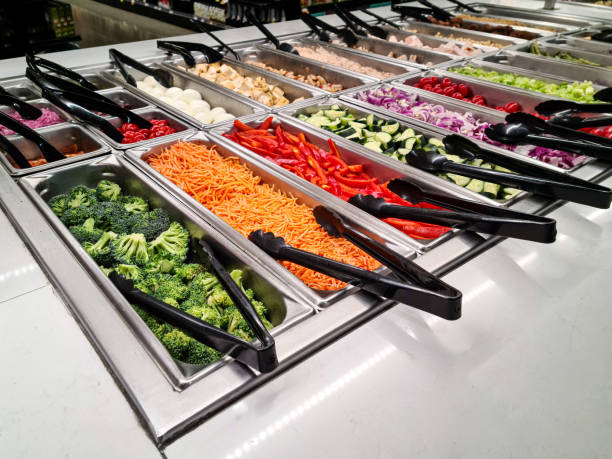When you step into a bustling buffet, the sight of a vast array of dishes spread out before you can be both enticing and overwhelming. From savory entrees to delectable desserts, buffets offer a tantalizing selection of food. But have you ever wondered how all that food remains fresh and safe to eat throughout the day?
1. Temperature Control: Buffets operate on a fine balance of keeping food at safe temperatures. The “Danger Zone” for food is between 40°F (4°C) and 140°F (60°C). This is the range where bacteria can multiply rapidly. To prevent this, hot foods are kept above 140°F, and cold dishes below 40°F. Buffets employ warming trays, chafing dishes, refrigerated displays, and ice beds to maintain these temperatures.
2. Steam Tables: Steam tables are a common sight in buffets. These heated tables use water to generate steam, which in turn keeps food hot without overcooking it. This method is particularly effective for dishes that require moist heat, like stews and gravies.
3. Induction Heating: Some buffets utilize induction heating to maintain food temperatures. Induction heating is highly efficient, and it allows for precise temperature control, ensuring that dishes are kept at the right serving temperature without overcooking.
4. Refrigeration: Cold dishes are crucial in a buffet’s lineup. Refrigerated displays with temperature controls keep salads, cold cuts, and desserts fresh and safe. The air circulation system in these units prevents condensation, maintaining the quality of the food.
5. Ice Beds and Chillers: Seafood, salads, and sushi are often placed on ice beds or chillers. These keep the food cold while preventing it from becoming waterlogged, ensuring it stays appetizing.
6. Cross-Contamination Prevention: Buffets are meticulous about preventing cross-contamination. Utensils are placed in a way that the handles do not touch the food. Sneezeguards and acrylic screens protect dishes from airborne contaminants.
7. FIFO (First In, First Out): Buffet staff adheres to the FIFO rule when replenishing dishes. The freshest food goes at the back, pushing older food to the front. This ensures that food doesn’t sit out for extended periods.
8. Microbial Testing: Many buffets conduct regular microbial testing to monitor food safety. This ensures that foodborne pathogens are not present in the dishes they serve.
9. High-Quality Containers: Buffets use high-quality containers to store food. Properly sealed containers prevent moisture from escaping, maintaining the food’s quality and preventing it from drying out.
10. Labeling and Date-Marking: Buffets are diligent about labeling and date-marking food containers. This allows staff to keep track of when the food was prepared and when it should be discarded.
11. Employee Training: The staff at buffets are well-trained in food safety protocols. They understand the importance of temperature control, cleanliness, and hygiene in preserving food quality.
12. Rotation of Dishes: Dishes on the buffet line are constantly rotated, ensuring that fresh batches are frequently added. This practice prevents food from sitting out too long, thus maintaining its taste and safety.
13. Reheating Methods: Buffets use proper reheating methods to ensure that dishes maintain their original quality. For instance, convection ovens are used to reheat fried items, so they remain crispy.
14. Dessert Preservation: Buffets go to great lengths to preserve the quality of desserts. Items like cakes and pastries are often stored in refrigerated displays to maintain freshness.
15. Humidity Control: Some buffets use humidity control systems to keep food at the right moisture levels. This is especially important for dishes that can dry out or become soggy, such as roasted meats and pastas.
16. Ingredient Separation: Ingredients for dishes like salads are often separated until they are served. This helps maintain the crispness of items like lettuce and keeps dressings from making the dish soggy.
17. Buffet Layout: Buffets are strategically laid out to ensure that food items requiring specific temperature ranges are located appropriately. For example, hot dishes are placed near heating elements, while cold dishes are positioned over ice beds.
18. Food-Waste Management: Reducing food waste is a significant concern for buffets. To prevent overproduction, they closely monitor customer preferences and adjust their menus accordingly.
19. Sensory Preservation: Buffets also take into account the sensory experience of food. Food should look, smell, and taste good. The preservation techniques aim to maintain the sensory appeal of the dishes.
20. Quality Ingredients: The science of food preservation starts with quality ingredients. Buffets prioritize using fresh and high-quality ingredients, which inherently extend the shelf life of the dishes.
